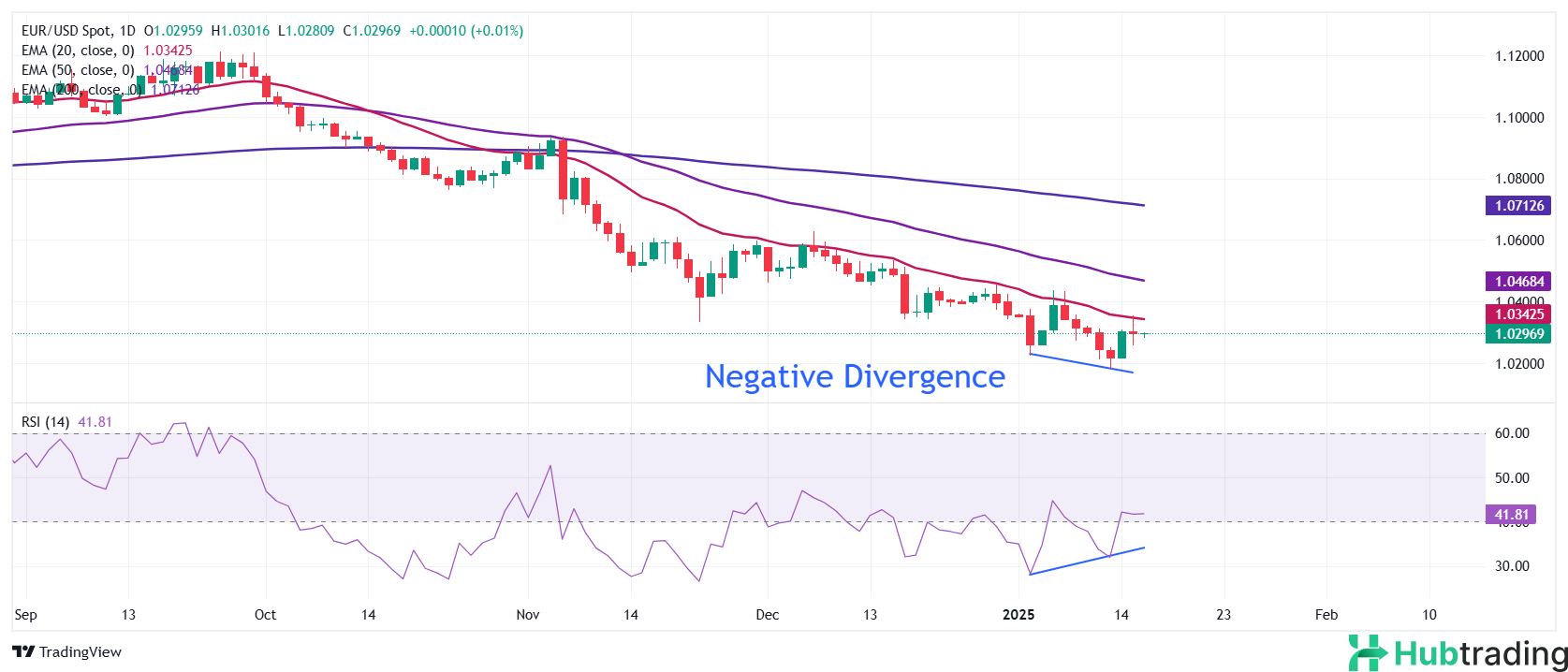- EUR/USD slips slightly below 1.0300 as the US Dollar strengthens, despite traders reassessing the Fed’s interest rate outlook for the year.
- Traders anticipate at least one interest rate cut this year following mixed US inflation data for December.
- ECB’s Villeroy forecasts the deposit facility rate to fall to 2% by mid-year.
EUR/USD dropped on Thursday following the release of the European Central Bank (ECB) Accounts, which revealed that all officials were in favor of a gradual interest rate reduction. The ECB expressed confidence that inflation would return to target by the first half of 2025, with the meeting minutes from December 11-12 stating that “if the baseline projection for inflation was confirmed over the next few months and quarters, a gradual dialing-back of policy restrictiveness was seen as appropriate.”
A Reuters poll conducted from January 10-15 showed that all 77 economists surveyed expect the ECB to reduce the Deposit Facility rate by 25 basis points (bps) to 2.75% in the upcoming January meeting. Furthermore, 60% of respondents anticipate three additional 25 bps cuts by mid-year.
ECB officials are also on board with expectations that the Deposit Rate could slide to 2% by the summer. François Villeroy de Galhau, ECB policymaker and Governor of the Bank of France, stated, “It makes sense for interest rates to reach 2% by the summer,” emphasizing that the ECB has “practically won the battle against inflation.” He also noted that reducing borrowing costs would support “financing the economy” and help reduce the household savings rate.
The outlook for the Eurozone economy remains uncertain, as concerns grow over the potential impact of higher import tariffs under the Trump administration, which could heavily affect the export sector.
Daily Digest Market Movers: EUR/USD Slides Despite Higher US Jobless Claims and Modest Retail Sales Growth
- EUR/USD drops below 1.0300 during Thursday’s North American session as the US Dollar strengthens, with the US Dollar Index (DXY) rising to around 109.25. The USD Index recovers most of the losses from Wednesday, which were driven by mixed US Consumer Price Index (CPI) data for December.
- The US CPI report showed mixed price pressures. Year-on-year, headline inflation accelerated as expected, while the core reading rose at a slower pace than anticipated. These mixed inflation signals caused traders to reassess their expectations for the Federal Reserve’s (Fed) monetary policy.
- According to the CME FedWatch tool, traders are now expecting more than one interest rate cut this year, in line with projections from the December Summary of Economic Projections (SEP). Before Wednesday’s CPI data, traders had only expected one rate cut in 2025.
- However, Fed officials remain concerned about the inflation outlook amid uncertainty regarding policies under President-elect Donald Trump’s administration. In a speech on Wednesday, New York Fed Bank President John Williams stated that while the disinflation process is “in train,” the economic outlook remains uncertain, particularly due to potential fiscal, trade, immigration, and regulatory policy changes.
- US Initial Jobless Claims for the week ending January 10 came in higher than expected, with 217K claims, surpassing the forecast of 210K and the previous release of 203K. US Retail Sales for December grew by 0.4%, below expectations of 0.6%, and a slowdown from November’s 0.8% growth.
Technical Analysis: EUR/USD Stabilizes Near 1.0300 After Bounce from Two-Year Low

EUR/USD holds its rebound near 1.0300 after recovering from the over-two-year low of 1.0175 hit on Monday. The pair has bounced due to divergence between momentum and price action, with the 14-day Relative Strength Index (RSI) forming a higher low around 35.00, while the pair itself made lower lows.
However, the overall outlook for the pair remains bearish, as all short-to-long-term Exponential Moving Averages (EMAs) continue to slope downward.
To the downside, Monday’s low of 1.0175 serves as a key support level. On the upside, the January 6 high of 1.0437 is the critical resistance for Euro bulls to overcome.





